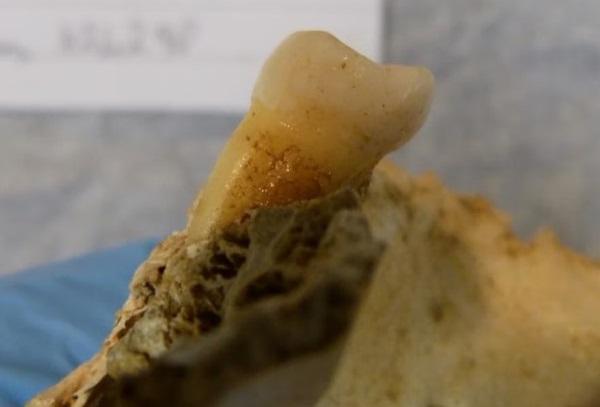One of two teeth found before samples were taken for DNA analysis.

Genetic analysis of the microbiomes of two 4,000-year-old teeth shows marked changes in oral microbiome since the Bronze Age, especially after heavy consumption of sugar, according to a study.
Even though the teeth belonged to the same person, they were found to have different genomes of Tannerella forsythia (T. forsythia), a bacterium that causes gum disease. Moreover, other ancient genomes have shed light on human history. Streptococcus mutans (S. mutans), a major causative agent of dental caries, has yet to be identified in preserved specimens. However, teeth discovered in an Irish limestone cave contained S. mutans, indicating significant changes in the oral microbiota throughout history, the authors write.
“These results highlight that recent cultural changes, such as the popularization of sugar, are most important for understanding the formation of modern oral pathobiont diversity,” write the authors, led by Lara Cassidy, PhD, assistant professor at the Dublin School of Genetics and Microbiology at Trinity College in Ireland. .
Following the discovery of the two teeth, ancient DNA analysis was carried out and it was determined that they both belonged to the same adult male who lived between 2280 and 2140 BC. Samples were taken from both teeth twice: from the root and from the crown. The metagenomic profiles of these samples were assessed and compared with publicly available data on ancient teeth and calculus, the authors write.
A team of scientists reconstructed the ancient genomes of T. forsythia and S. mutans, revealing significant changes in the populations and functions of oral bacteria over the past 750 years. They found distinct differences in virulence factors between pre-industrial and post-industrial genomes, which were particularly pronounced in T. forsythia.
These changes likely affected the host's immune response and interactions with other oral microbes. Even analysis of just one ancient S. mutans genome suggests that the modern set of mutacins has emerged recently, they write.
The populations of both S. mutans and T. forsythia expanded after the medieval period, with S. mutans showing greater diversification. About 600 years ago, the population of T. forsythia exploded, coinciding with an increase in sugar in the diet. Known for thriving in high-sucrose environments, S. mutans uses sucrose to produce glucans that promote biofilm formation and maintain a low pH, giving it an advantage in acid resistance, according to the study.
Cassidy and co-authors added that in the future, expanded sampling of ancient microbial populations could provide new insights into the evolutionary processes governing the development of bacterial taxa, adaptation, and the maintenance of diversity across species and environmental factors.
“Overall, the results of our study demonstrate the utility of ancient genomes for characterizing different modes of pathobiont evolution,” they concluded.
